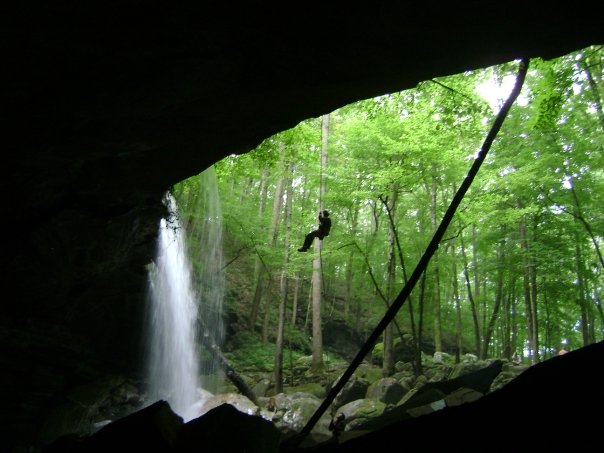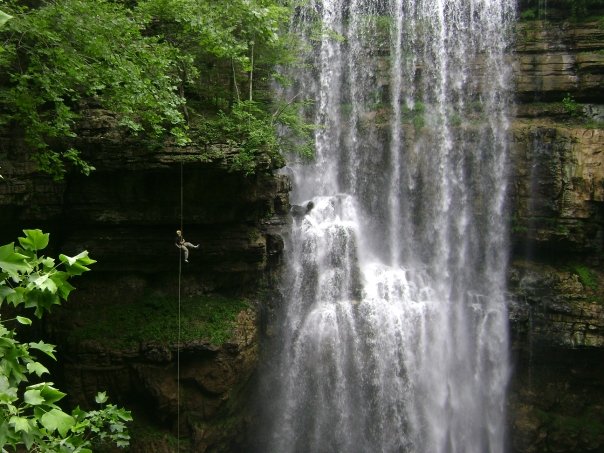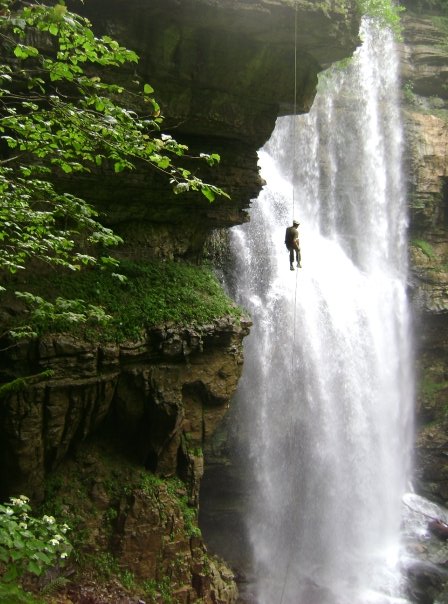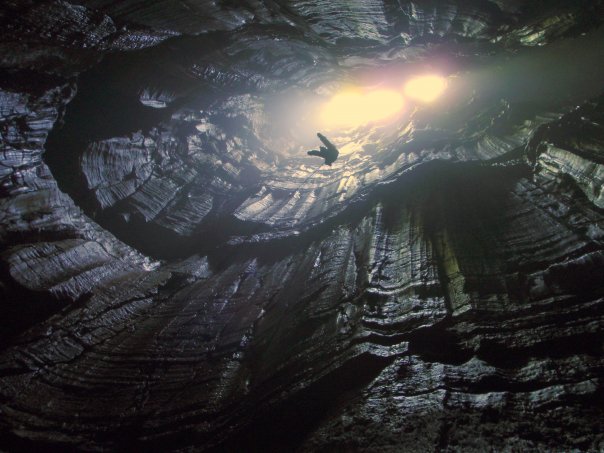
Personally, I find neither of these quite so fascinating as that part of caving that goes on above-ground. The house where I spent the first year of my life, one day unexpectedly sank into an underground reservoir, which was part of a massive network of underground cavities that ran underneath most of northern Florida and the southeast. The university where I would spend an inordinately large portion of my youth was interspersed with dozens of sinkholes and once navigable passageways. I would crawl, walk, bike, and drive over hundreds of miles of caves for the better part of 23 years without ever really acknowledging their existence, much less their exploration. The sport is an invitation to another world, a parallel dimension that is always close at hand, but always invisible. Cavers are the guardians of the portals to this world, of the arcane secrets needed to access them. In a time when Google can yield virtually any answer on any subject in a fraction of a second, a search for a list of caves, their locations, or instructions for their access will return nothing. The risks to this fragile world, and any who might dare to explore its depths, are far too great to allow for just anyone to enter.
And so for the past three years, I have done everything I can to share this hidden world with as many people as possible. It is certainly not a sport for everyone, and getting any non-caver into a cave, especially where vertical is involved, can be a Herculean feat. In densely-populated or cave-sparse areas, you typically have gates, hard-to-reach contacts, and 2-week-in-advance reservations, while elsewhere, you might spend hours bushwhacking through dense forest, carefully examining every ridge with the hope that a tiny, squeezable cave mouth might appear. When on rope, beginners' mistakes can easily result in an uncontrolled 20-story drop, which, even for the more resilient among us, can be a difficult thing to walk away from, and is typically not well received by said beginner's family.
All this being said, Virgin Falls Pocket Wilderness is a great place to take those new to the sport. It's impossible to walk the 10-mile trail without seeing at least half a dozen gaping entrances, and there are a slew of places to do some epic vertical work with a convenient fireman's belay. I've already covered the place in the southeast roadtrip post, but this time we had Phillip, ropes expert and crazy climber extraordinaire, to set up a rappel off of the lip of the waterfall-fronted cavern where we had camped the night before (refreshingly misty in the summertime, quite cold in the winter), and another down the side of the 120-foot Virgin Falls.



The following weekend, with our taste for vertical piqued, Phillip and I headed for some not-so-beginner-friendly pits. We figured since it was just the two of us, and since I, the less fit of the pair, could ascend out of a 160-foot pit in seven minutes flat, we could drop five to six pits over the course of Saturday's daylight hours. We neglected to figure a number of things into our calculations however: 1) we had no idea where four of the six pits were, 2) having arrived in Chattanooga around 1am, there was no way we were taking advantage of all the daylight hours, 3) the last time I had ascended out of anything was two years prior when I had been actively training for a marathon.
We first headed to South Pittsburg and grabbed breakfast at Harvey's Pirate Diner; I thought it a bit incongruous that a diner catering to pirates should be several hundred miles from the nearest ocean, but it seemed to be popular enough with the locals. I ordered biscuits and gravy and a pint of milk; a pint is a good bit of whole milk to drink in one sitting, but even before I finished, they brought me a refill, and so I would set off into the wilderness (and a mile of bathroomless cave passage) with a full liter in my rumbling belly. Each of our bills came to $3 even, despite the prices on the menu being considerably higher. There was an airstream serving triple-thick milkshakes across the street, but sadly it would not open for another few hours.
Our directions to the cave started out "turn right on one of the roads - I don't remember which - try asking someone", and so we found a knowledgeable local, and were soon hiking up through a forest of kudzu to the 160' South Pittsburg Pit. We tied the rope to a tree, geared up, and each took our turn swinging down into the abyss.
The drop was spectacular and the cave at the bottom looked like great fun, with a number of rope-assisted climbs and high ceilings, but I had done in my knee while biking the day before, and there was of course the matter of the milk, so we were shortly ascending back towards the roof. This ascent took me about 25 minutes and left me drenched in sweat and gasping for air; I vowed to start running again once I returned to Gainesville.
The next pit, Valhalla, was accessed by a treacherous, rocky streambed which was clearly not designed with our low-clearance station wagon in mind. We made it about two miles in and then abandoned our car to trek the remaining mile; the pit was only a hundred feet from the designated parking lot. Valhalla is thought by some to be haunted - in the 80s, a pair of college kids were crushed by a schoolbus-sized boulder that unexpectedly detached from the ceiling at a most inopportune time - I found this a tad unnerving until I stepped off the ledge and found myself suspended 230 feet above the cavern's floor - at that point, a possible inhabitation by ghosts had about as much effect on me as if someone had told me the cave was frequented by fuzzy caterpillars. This drop was a hundred times as spectacular as the last, and the cave at the bottom was just as extensive (and we might have seen more of it had I not left the map in the car).
Vertical caving is a great way to rediscover a latent fear of heights. The rappel is not so bad; you take about two to three minutes to pull off a slow, smooth, awe-stricken descent, and then it's over. Ascending gives you much more of a chance to look around and think. Over the course of the thirty minutes I spent rising out of Valhalla, I thought about many things - about my gear's uncertain grip as I repeatedly jerked it upward toward the exit, about the sawing motion of the rope on the lip as I gently swung to and fro, about the schoolbus-sized rock and the pulverized bodies forever trapped underneath, about the tiny speck that danced around on the floor below, which in other contexts I understood to be a living, breathing person not too much smaller than myself - these all ran through my mind, and left me the slightest bit unsettled.
With our hours of daylight quickly slipping away, we scrapped plans for doing Neversink and Stephen's Gap, and headed for Moses' Tomb. For this cave, we had no more direction than the name of a mountain, which was around ten miles long and had at least half a dozen access roads running up to its heights. I took us to the one access I knew from previous trips, and here we had the good fortune of coming across three other cavers who happened to be going to the exact same place. Unlike many of the pits in the area, which are epic crevasses even from the surface, Moses was no more than a tiny hole in the hillside that one person at a time could squeeze through. This quickly opened up into a 240-foot descent, running along one massive, continuous flowstone. There was no cave at the bottom, so it was purely an exercise in getting the five of us down and back up again, which would take no less than three hours.
We got back to the car around 10:30 and Philip checked his phone for the first time in 12 hours. Over the speakerphone came a set of rather frantic messages from our friends Nick and Julie, who had spent the day climbing in Chattanooga. It seemed we had not been particularly explicit with our caving plans, and had, at any rate, not bothered to call them when we exited the earlier cave (you should always have an emergency contact that you call before AND after caving), and they had independently concluded that 4PM was the appropriate time for us to report back to them. So emergency services was called and a crack team of cave rescue specialists was assembled and sent to the pit, fully prepared to wipe up our shattered bodies from the floor of Valhalla (which incidentally, and this is an important point that I failed to mention earlier, was not covered in a twenty-foot layer of air mattresses or marshmallow fluff). This would not do much for my future efforts to gain access to the mysterious secrets of the underground world.
